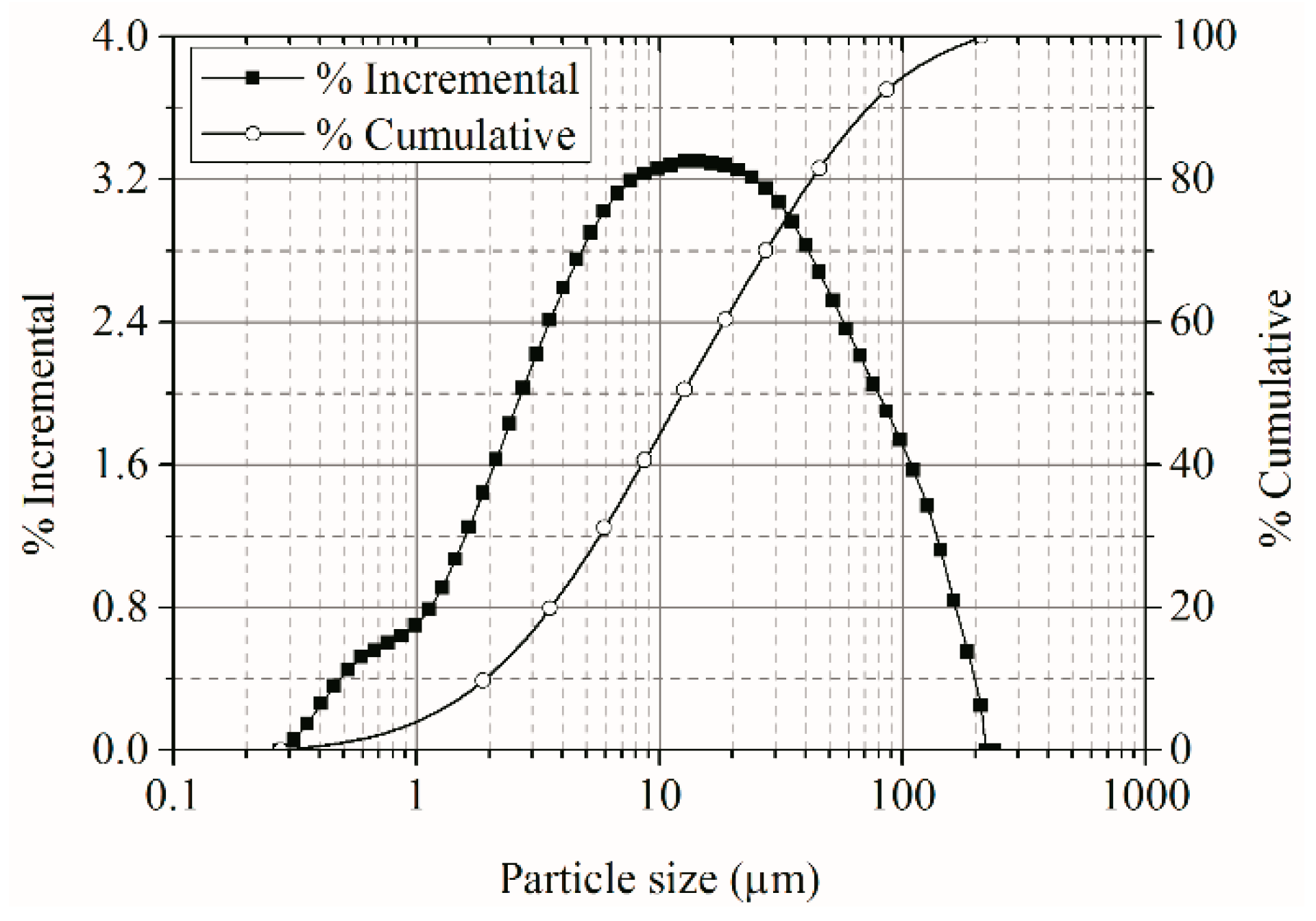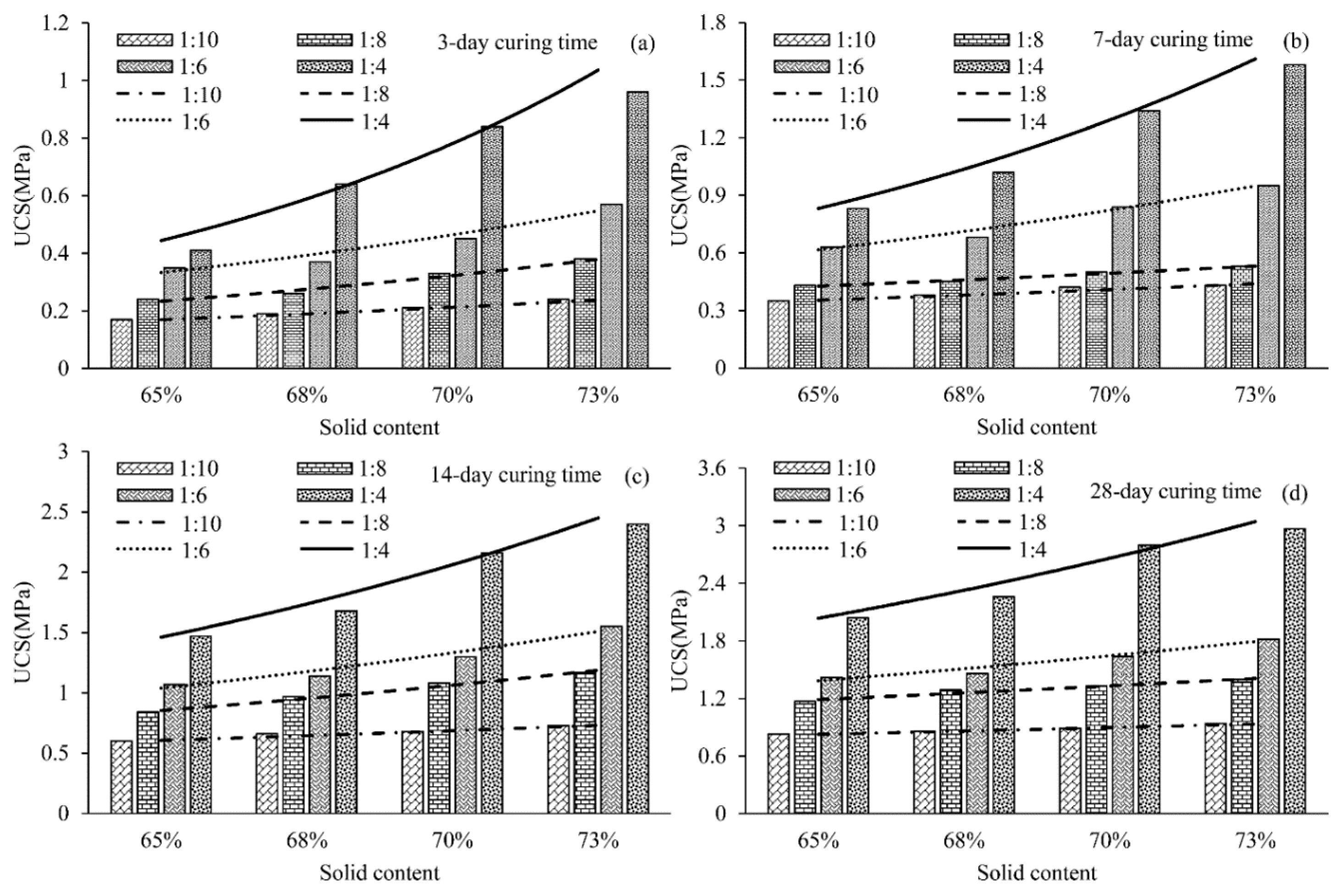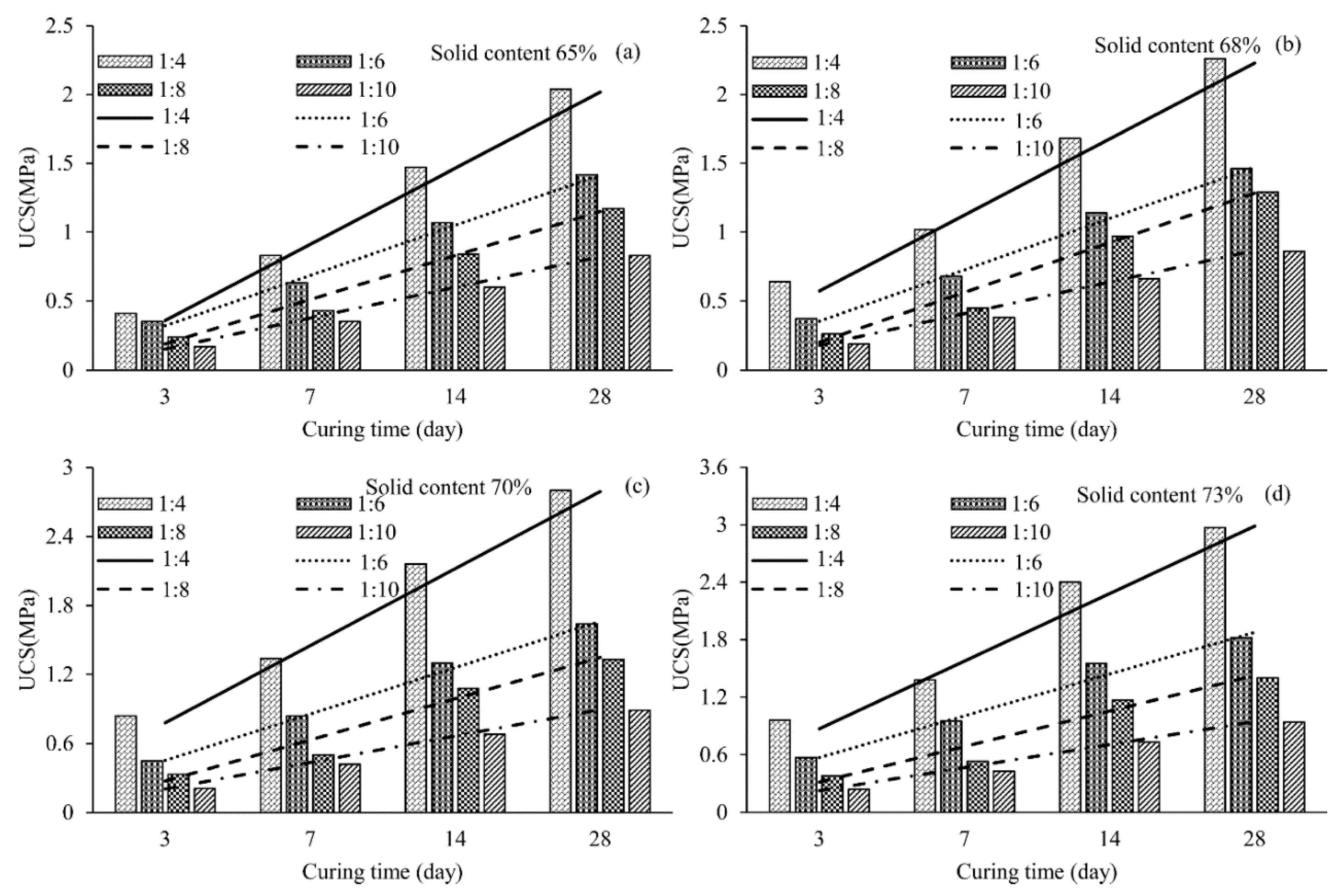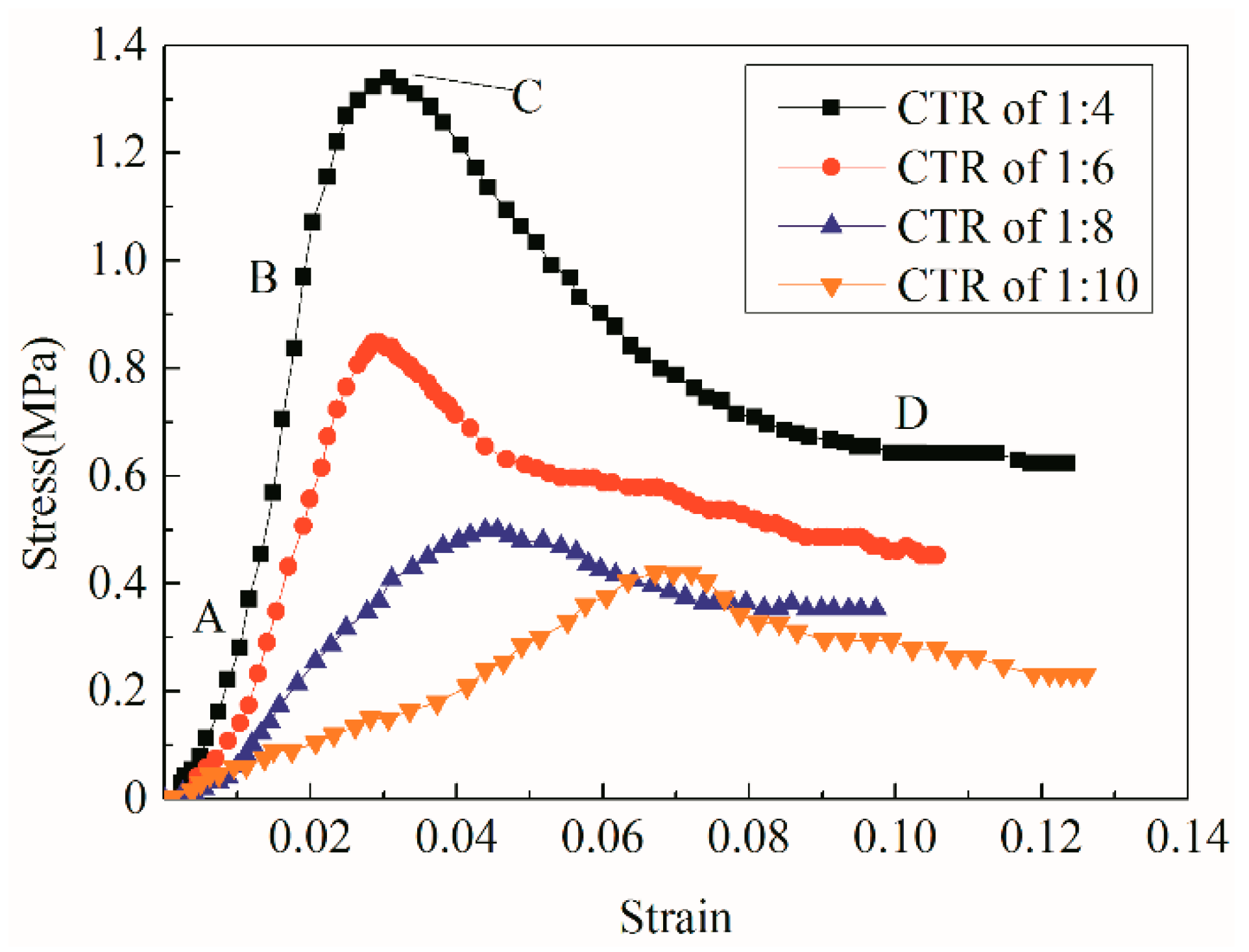Strength Characteristics and Failure Mechanism of Cemented Super-Fine Unclassified Tailings Backfill
Abstract
:1. Introduction
2. Materials and Methods
2.1. Tailings, Binder and Mixing Water
2.2. Specimen Preparation
2.3. Uniaxial Compression Tests
3. Results and Discussion
3.1. Strength Characteristics of CSUTB
3.1.1. Effect of CTR
3.1.2. Effect of Solid Content
3.1.3. Effect of Curing Time
3.2. Sensitivity of Strength to Influencing Factors
3.3. Failure Process and Mechanism of CSUTB
4. Conclusions
- (1)
- ZGIM tailings is a super-fine and alkaline tailings with high quality and activity. The non-uniform coefficient of the tailings is 8.6, meaning a good gradation.
- (2)
- The effects of the CTR, solid content and curing time on the UCS of CSUTB are investigated. When the other two factors are fixed, the UCS of CSUTB increases exponentially with the increase of CTR and solid content, while increases linearly with curing time. The sensitivity of UCS to curing time is strongest, with a correlation degree of 0.728, and the sensitivity is weakest to solid content, with a correlation degree of 0.689.
- (3)
- The failure process of CSUTB is divided into four stages including initial deformation, linear elastic deformation, yield deformation and complete failure. The damage of the CSUTB is attributed to the accumulation of micro cracks and concentration of partial stresses, and the evolution of damage leads to complete failure of CSUTB.
- (4)
- Future studies are required to investigate the strength characteristics of CSUTB under complex mechanical conditions, explore the hydration mechanism of CSUTB and compare it to normal CPB, and test the long term performance of CSUTB.
Acknowledgments
Author Contributions
Conflicts of Interest
References
- Zhang, T.J.; Ma, M.; Wang, H.S.; Xu, H.G. A nonlinear rheological model of backfill material for retaining roadways and the analysis of its stability. Min. Sci. Technol. China 2011, 21, 543–546. [Google Scholar] [CrossRef]
- Li, L.; Aubertin, M. A modified solution to assess the required strength of exposed backfill in mine stopes. Can. Geotech. J. 2012, 49, 994–1002. [Google Scholar] [CrossRef]
- Cai, S.J.; Huang, G.; Wu, D.; Zhang, Y.D. Experimental and Modeling Study on the Rheological Properties of Tailings Backfill. J. Northeast. Univ. Nat. Sci. 2015, 36, 882–886. [Google Scholar]
- Li, L.; Aubertin, M. An improved method to assess the required strength of cemented backfill in underground stopes with an open face. Int. J. Min. Sci. Technol. 2014, 24, 549–558. [Google Scholar] [CrossRef]
- Belem, T.; Benzaazoua, M. Design and Application of Underground Mine Paste Backfill Technology. Geotech. Geol. Eng. 2008, 26, 147–174. [Google Scholar] [CrossRef]
- Dong, L.; Gao, Q.; Nan, S.Q.; Du, J. Performance and hydration mechanism of new super fine cemented whole-tailings backfilling materials. J. Cent. South Univ. Sci. Technol. 2013, 44, 1571–1577. [Google Scholar]
- Li, J.; Zhang, J.X.; Huang, Y.L.; Zhang, Q.; Xu, J.M. An investigation of surface deformation after fully mechanized, solid back fill mining. Int. J. Min. Sci. Technol. 2012, 22, 453–457. [Google Scholar] [CrossRef]
- Doherty, J.P. A numerical study into factors affecting stress and pore pressure in free draining mine stopes. Comput. Geotech. 2015, 63, 331–341. [Google Scholar] [CrossRef]
- Yilmaz, E.; Belem, T.; Benzaazoua, M. Specimen size effect on strength behavior of cemented paste backfills subjected to different placement conditions. Eng. Geol. 2015, 185, 52–62. [Google Scholar] [CrossRef]
- Fall, M.; Benzaazoua, M.; Ouellet, S. Experimental characterization of the influence of tailings fineness and density on the quality of cemented paste backfill. Miner. Eng. 2005, 18, 41–44. [Google Scholar] [CrossRef]
- Fall, M.; Pokharel, M. Coupled effects of sulphate and temperature on the strength development of cemented tailings backfills: Portland cemen-paste backfill. Cem. Concr. Compos. 2010, 32, 819–828. [Google Scholar] [CrossRef]
- Kesimal, A.; Yilmaz, E.; Ercikdi, B.; Alp, I.; Deveci, H. Effect of properties of tailings and binder on the short- and long-term strength and stability of cemented paste backfill. Mater. Lett. 2005, 59, 3703–3709. [Google Scholar] [CrossRef]
- Ercikdi, B.; Külekci, G.; Yilmaz, T. Utilization of granulated marble and waste bricks as mineral admixture in cemented paste backfill of sulphide-rich tailings. Constr. Build. Mater. 2015, 93, 573–583. [Google Scholar] [CrossRef]
- Yilmaz, E.; Benzaazoua, M.; Belem, T.; Bussière, B. Effect of curing under pressure on compressive strength development of cemented paste backfill. Miner. Eng. 2009, 22, 772–785. [Google Scholar] [CrossRef]
- Yilmaz, E.; Belem, T.; Benzaazoua, M. Effects of curing and stress conditions on hydromechanical, geotechnical and geochemical properties of cemented paste backfill. Eng. Geol. 2014, 168, 23–37. [Google Scholar] [CrossRef]
- Fall, M.; Samb, S.S. Effect of high temperature on strength and microstructural properties of cemented paste backfill. Fire Saf. J. 2009, 44, 642–651. [Google Scholar] [CrossRef]
- Yi, X.W.; Ma, G.W.; Fourie, A. Compressive behaviour of fibre-reinforced cemented paste backfill. Geotext. Geomembr. 2015, 43, 207–215. [Google Scholar] [CrossRef]
- Zheng, J.R.; Zhu, Y.L.; Zhao, Z.B. Utilization of limestone powder and water-reducing admixture in cemented paste backfill of coarse copper mine tailings. Constr. Build. Mater. 2016, 124, 31–36. [Google Scholar] [CrossRef]
- Koohestani, B.; Koubaa, A.; Belem, T.; Bussière, B.; Bouzahzah, H. Experimental investigation of mechanical and microstructural properties of cemented paste backfill containing maple-wood filler. Constr. Build. Mater. 2016, 121, 222–228. [Google Scholar] [CrossRef]
- Koohestani, B.; Belem, T.; Koubaa, A.; Bussière, B. Experimental investigation into the compressive strength development of cemented paste backfill containing Nano-silica. Cem. Concr. Compos. 2016, 72, 180–189. [Google Scholar] [CrossRef]
- Fall, M.; Belem, S.; Samb, T.; Benzaazoua, M. Experimental characterization of the stress–strain behaviour of cemented paste backfill in compression. J. Mater. Sci. 2007, 42, 3914–3922. [Google Scholar] [CrossRef]
- Benzaazoua, M.; Fall, M.; Belem, T. A contribution to understanding the hardening process of cemented pastefill. Miner. Eng. 2004, 17, 141–152. [Google Scholar] [CrossRef]
- Ercikdi, B.; Kesimal, A.; Cihangir, F.; Deveci, H.; Alp, İ. Cemented paste backfill of sulphide-rich tailings: Importance of binder type and dosage. Cem. Concr. Compos. 2009, 31, 268–274. [Google Scholar] [CrossRef]
- Ercikdi, B.; Clhangir, F.; Kesimal, A.; Deveci, H.; Alp, I. Utilization of water-reducing admixtures in cemented paste backfill of sulphide-rich mill tailings. J. Hazard. Mater. 2010, 179, 940–946. [Google Scholar] [CrossRef] [PubMed]
- Li, W.C.; Fall, M. Sulphate effect on the early age strength and self-desiccation of cemented paste backfill. Constr. Build. Mater. 2016, 106, 296–304. [Google Scholar] [CrossRef]
- Hou, P.K.; Kawashima, S.H.; Wang, K.J.; Corr, D.J.; Qian, J.S.; Shah, S.P. Effects of colloidal nanosilica on rheological and mechanical properties of fly ash–cement mortar. Cem. Concr. Compos. 2013, 35, 12–22. [Google Scholar] [CrossRef]
- Fall, M.; Ghirian, A. Coupled thermo–hydro-mechanical–chemical evolution of cemented paste backfill and implications for backfill design-experimental results. In Proceedings of the 11th International Symposium on Mining with Backfill (Mine Fill 2014), Perth, Australia, 20–22 May 2014; Australian Centre for Geomechanics: Crawley, Australia, 2014. [Google Scholar]
- Abdul-Hussain, N.; Fall, M. Thermo–hydro-mechanical behaviour of sodium silicate-cemented paste tailings in column experiments. Tunn. Undergr. Space Technol. 2012, 29, 85–93. [Google Scholar] [CrossRef]
- Cui, L.; Fall, M. A coupled thermo–hydro-mechanical–chemical model for underground cemented tailings backfill. Tunn. Undergr. Space Technol. 2015, 50, 396–414. [Google Scholar] [CrossRef]
- Ghirian, A.; Fall, M. Coupled thermo-hydro-mechanical–chemical behaviour of cemented paste backfill in column experiments. Part I: Physical, hydraulic and thermal processes and characteristics. Eng. Geol. 2013, 164, 195–207. [Google Scholar] [CrossRef]
- Wu, D.; Sun, G.H.; Liu, Y.C. Modeling the thermo-hydro-chemical behavior of cemented coal gangue-fly ash backfill. Constr. Build. Mater. 2016, 111, 522–528. [Google Scholar] [CrossRef]
- Yilmaz, E.; Belem, T.; Bussière, B.; Benzaazoua, M. Relationships between microstructural properties and compressive strength of consolidated and unconsolidated cemented paste backfills. Cem. Concr. Compos. 2011, 33, 702–715. [Google Scholar] [CrossRef]
- Yilmaz, E.; Belem, T.; Bussière, B.; Mbonimpa, M.; Benzaazoua, M. Curing time effect on consolidation behaviour of cemented paste backfill containing different cement types and contents. Constr. Build. Mater. 2015, 75, 99–111. [Google Scholar] [CrossRef]
- Ercikdi, B.; Yılmaz, T.; Külekci, G. Strength and ultrasonic properties of cemented paste backfill. Ultrasonics 2014, 54, 195–204. [Google Scholar] [CrossRef] [PubMed]
- Huang, S.; Xia, K.W.; Qiao, L. Dynamic tests of cemented paste backfill: Effects of strain rate, curing time, and cement content on compressive strength. J. Mater. Sci. 2011, 46, 5165–5170. [Google Scholar] [CrossRef]
- Kesimal, A.; Yilmaz, E.; Ercikdi, B. Evaluation of paste backfill mixtures consisting of sulphide-rich mill tailings and varying cement contentse. Cem. Concr. Res. 2004, 34, 1817–1822. [Google Scholar] [CrossRef]
- Yin, S.H.; Wu, A.X.; Hu, K.J.; Wang, Y.; Zhang, Y.K. The effect of solid components on the rheological and mechanical properties of cemented paste backfill. Miner. Eng. 2012, 35, 61–66. [Google Scholar] [CrossRef]
- Fall, M.; Benzaazoua, M.; Saa, E.G. Mix proportioning of underground cemented tailings backfill. Tunn. Undergr. Space Technol. 2008, 23, 80–90. [Google Scholar] [CrossRef]
- Li, S.; Wang, X.M.; Zhang, Q.L.; Wang, S. Time-Varying Characteristic of Paste-like Super-Fine Unclassified Tailings in Long Self-Flowing Transportation. J. Northeast. Univ. Nat. Sci. 2016, 37, 1045–1050. [Google Scholar]
- Zhang, Q.L.; Li, X.P.; Yang, W. Optimization of filling slurry ratio in a mine based on back-propagation neural network. J. Cent. South Univ. Sci. Technol. 2013, 44, 2867–2874. [Google Scholar]
- Xu, W.B.; Du, J.H.; Song, W.D.; Chen, H.Y. Experiment on the mechanism of consolidating backfill body of extra-fine grain unclassified tailings and cementitious materials. Rock Soil Mech. 2013, 34, 2295–2302. [Google Scholar]
- Common Portland Cement; Chinese Standard: GB 175-2007; Standardization Administration of China: Beijing, China, 2007.
- Yılmaz, T.; Ercikdi, B.; Karaman, K.; Külekçi, G. Assessment of strength properties of cemented paste backfill by ultrasonic pulse velocity test. Ultrasonics 2014, 54, 1386–1394. [Google Scholar] [CrossRef] [PubMed]
- Standard Test Method for Unconfined Compressive Strength of Cohesive Soil; ASTM D2166/D2166M-16; ASTM International: West Conshohocken, PA, USA, 2016.
- Fu, J.X.; Du, C.F.; Song, W.D. Strength sensitivity and failure mechanism of full tailings cemented backfills. J. Univ. Sci. Technol. Beijing 2014, 36, 1149–1157. [Google Scholar]
- Cao, S.G.; Xu, A.M.; Liu, Y.B.; Zhang, L.Q. Comprehensive assessment of security in coal mines based on grey relevance analysis. J. Min. Saf. Eng. 2007, 24, 141–145. [Google Scholar]
- Huang, D.L.; Lin, B. Sensitivity analysis on the influence factor of the mechanical properties of the artificial frozen soil. Mech. Eng. 2012, 34, 63–65. (In Chinese) [Google Scholar]






| Characteristic Diameter | d10 | d50 | d60 | d90 | d100 |
|---|---|---|---|---|---|
| Size (μm) | 2.17 | 14.2 | 18.7 | 82.9 | 211 |
| Composition | CaO | SiO2 | Fe2O3 | MgO | Al2O3 | SO3 | K2O | Na2O | TiO2 |
|---|---|---|---|---|---|---|---|---|---|
| Tailings | 44.41 | 20.91 | 16.39 | 11.30 | 3.22 | 2.23 | 0.52 | 0.39 | 0.10 |
| OPC | 60.51 | 22.86 | 3.35 | 1.57 | 5.45 | 3.01 | 0.56 | 0.25 | 0.11 |
| CTR | Solid Content | Curing Time (Day) |
|---|---|---|
| 1:4 | 65% | 3 |
| 1:6 | 68% | 7 |
| 1:8 | 70% | 14 |
| 1:10 | 73% | 28 |
| CTR | Curing Time (Day) | Solid Content | |||
|---|---|---|---|---|---|
| 65% | 68% | 70% | 73% | ||
| 1:4 | 3 | 0.41 | 0.64 | 0.84 | 0.96 |
| 7 | 0.83 | 1.02 | 1.34 | 1.58 | |
| 14 | 1.47 | 1.68 | 2.16 | 2.40 | |
| 28 | 2.04 | 2.26 | 2.80 | 2.97 | |
| 1:6 | 3 | 0.35 | 0.37 | 0.45 | 0.57 |
| 7 | 0.63 | 0.68 | 0.84 | 0.95 | |
| 14 | 1.07 | 1.14 | 1.30 | 1.55 | |
| 28 | 1.42 | 1.46 | 1.64 | 1.82 | |
| 1:8 | 3 | 0.24 | 0.26 | 0.33 | 0.38 |
| 7 | 0.43 | 0.45 | 0.50 | 0.53 | |
| 14 | 0.84 | 0.97 | 1.08 | 1.17 | |
| 28 | 1.17 | 1.29 | 1.33 | 1.40 | |
| 1:10 | 3 | 0.17 | 0.19 | 0.21 | 0.24 |
| 7 | 0.35 | 0.38 | 0.42 | 0.43 | |
| 14 | 0.60 | 0.66 | 0.68 | 0.73 | |
| 28 | 0.83 | 0.86 | 0.89 | 0.94 | |
| Curing Time (Day) | Fitting Type | Solid Content | ||||
|---|---|---|---|---|---|---|
| 65% | 68% | 70% | 73% | Average | ||
| 3 | linear | 0.9760 | 0.8712 | 0.7986 | 0.9216 | 0.8919 |
| exponential | 0.9533 | 0.9991 | 0.9836 | 0.9968 | 0.9832 | |
| 7 | linear | 0.9554 | 0.8834 | 0.8765 | 0.9143 | 0.9074 |
| exponential | 0.9816 | 0.9884 | 0.9845 | 0.9564 | 0.9778 | |
| 14 | linear | 0.9695 | 0.9282 | 0.8905 | 0.9448 | 0.9333 |
| exponential | 0.9909 | 0.9309 | 0.9401 | 0.9581 | 0.9550 | |
| 28 | linear | 0.9414 | 0.8974 | 0.8670 | 0.9051 | 0.9027 |
| exponential | 0.9694 | 0.9510 | 0.9606 | 0.9790 | 0.9650 | |
| Curing Time (Day) | Fitting Type | CTR | ||||
|---|---|---|---|---|---|---|
| 1:4 | 1:6 | 1:8 | 1:10 | Average | ||
| 3 | linear | 0.8883 | 0.9118 | 0.9324 | 0.9797 | 0.9281 |
| exponential | 0.8776 | 0.9348 | 0.9375 | 0.9837 | 0.9334 | |
| 7 | linear | 0.9739 | 0.9374 | 0.9347 | 0.9651 | 0.9528 |
| exponential | 0.9751 | 0.9410 | 0.9356 | 0.9593 | 0.9528 | |
| 14 | linear | 0.9481 | 0.9320 | 0.9888 | 0.9974 | 0.9666 |
| exponential | 0.9484 | 0.9492 | 0.9807 | 0.9964 | 0.9687 | |
| 28 | linear | 0.9232 | 0.9187 | 0.9695 | 0.9832 | 0.9487 |
| exponential | 0.9235 | 0.9242 | 0.9701 | 0.9860 | 0.9510 | |
| Solid Content | Fitting Type | CTR | ||||
|---|---|---|---|---|---|---|
| 1:4 | 1:6 | 1:8 | 1:10 | Average | ||
| 65% | linear | 0.9484 | 0.9382 | 0.9515 | 0.9457 | 0.9460 |
| exponential | 0.8269 | 0.8351 | 0.8507 | 0.8219 | 0.8337 | |
| 68% | linear | 0.9559 | 0.9204 | 0.9060 | 0.9233 | 0.9264 |
| exponential | 0.8702 | 0.8169 | 0.8207 | 0.8005 | 0.8271 | |
| 70% | linear | 0.9480 | 0.9078 | 0.8946 | 0.9267 | 0.9175 |
| exponential | 0.8818 | 0.7956 | 0.8288 | 0.8080 | 0.8286 | |
| 73% | linear | 0.9646 | 0.8723 | 0.8761 | 0.9190 | 0.9080 |
| exponential | 0.8983 | 0.7899 | 0.8245 | 0.8149 | 0.8319 | |
| CTR | Fitting Type | Solid Content | ||||
|---|---|---|---|---|---|---|
| 65% | 68% | 70% | 73% | Average | ||
| 1:4 | linear | 0.9484 | 0.9539 | 0.9480 | 0.9109 | 0.9403 |
| exponential | 0.8269 | 0.8702 | 0.8818 | 0.8189 | 0.8495 | |
| 1:6 | linear | 0.9382 | 0.9204 | 0.9078 | 0.8723 | 0.9097 |
| exponential | 0.8351 | 0.8169 | 0.7956 | 0.7899 | 0.8094 | |
| 1:8 | linear | 0.9512 | 0.9060 | 0.8946 | 0.8761 | 0.9077 |
| exponential | 0.8507 | 0.8207 | 0.8288 | 0.8245 | 0.8311 | |
| 1:10 | linear | 0.9457 | 0.9233 | 0.9267 | 0.9190 | 0.9287 |
| exponential | 0.8219 | 0.8005 | 0.8080 | 0.8149 | 0.8133 | |
| Group | γ01 (k) | γ02 (k) | γ03 (k) |
|---|---|---|---|
| 1 | 1.000 | 1.000 | 1.000 |
| 2 | 0.677 | 0.974 | 0.680 |
| 3 | 0.422 | 0.959 | 0.422 |
| 4 | 0.333 | 0.949 | 0.333 |
| 5 | 0.739 | 0.898 | 0.755 |
| 6 | 0.988 | 0.859 | 0.851 |
| 7 | 0.578 | 0.821 | 0.535 |
| 8 | 0.555 | 0.805 | 0.511 |
| 9 | 0.723 | 0.778 | 0.718 |
| 10 | 0.715 | 0.736 | 0.947 |
| 11 | 0.985 | 0.636 | 0.745 |
| 12 | 0.731 | 0.583 | 0.593 |
| 13 | 0.620 | 0.545 | 0.651 |
| 14 | 0.679 | 0.407 | 0.683 |
| 15 | 0.778 | 0.371 | 0.844 |
| 16 | 0.868 | 0.333 | 0.749 |
| correlational degree | 0.712 | 0.728 | 0.689 |
© 2017 by the authors. Licensee MDPI, Basel, Switzerland. This article is an open access article distributed under the terms and conditions of the Creative Commons Attribution (CC BY) license (http://creativecommons.org/licenses/by/4.0/).
Share and Cite
Qiu, J.; Yang, L.; Sun, X.; Xing, J.; Li, S. Strength Characteristics and Failure Mechanism of Cemented Super-Fine Unclassified Tailings Backfill. Minerals 2017, 7, 58. https://doi.org/10.3390/min7040058
Qiu J, Yang L, Sun X, Xing J, Li S. Strength Characteristics and Failure Mechanism of Cemented Super-Fine Unclassified Tailings Backfill. Minerals. 2017; 7(4):58. https://doi.org/10.3390/min7040058
Chicago/Turabian StyleQiu, Jingping, Lei Yang, Xiaogang Sun, Jun Xing, and Songbo Li. 2017. "Strength Characteristics and Failure Mechanism of Cemented Super-Fine Unclassified Tailings Backfill" Minerals 7, no. 4: 58. https://doi.org/10.3390/min7040058






